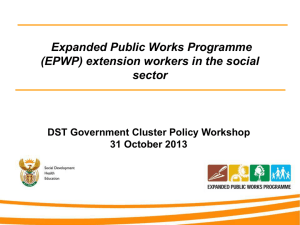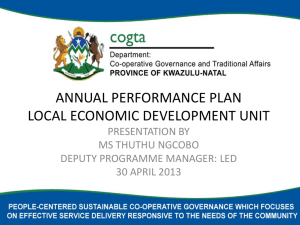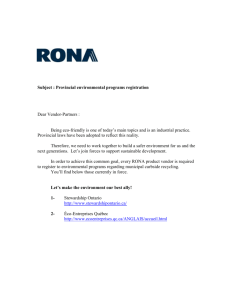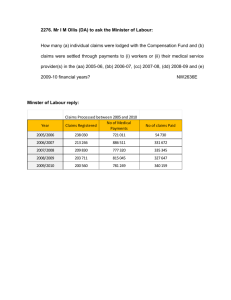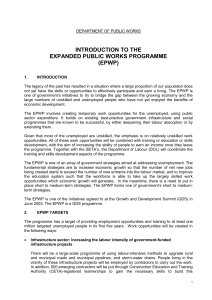Infrastructure Sector Plan
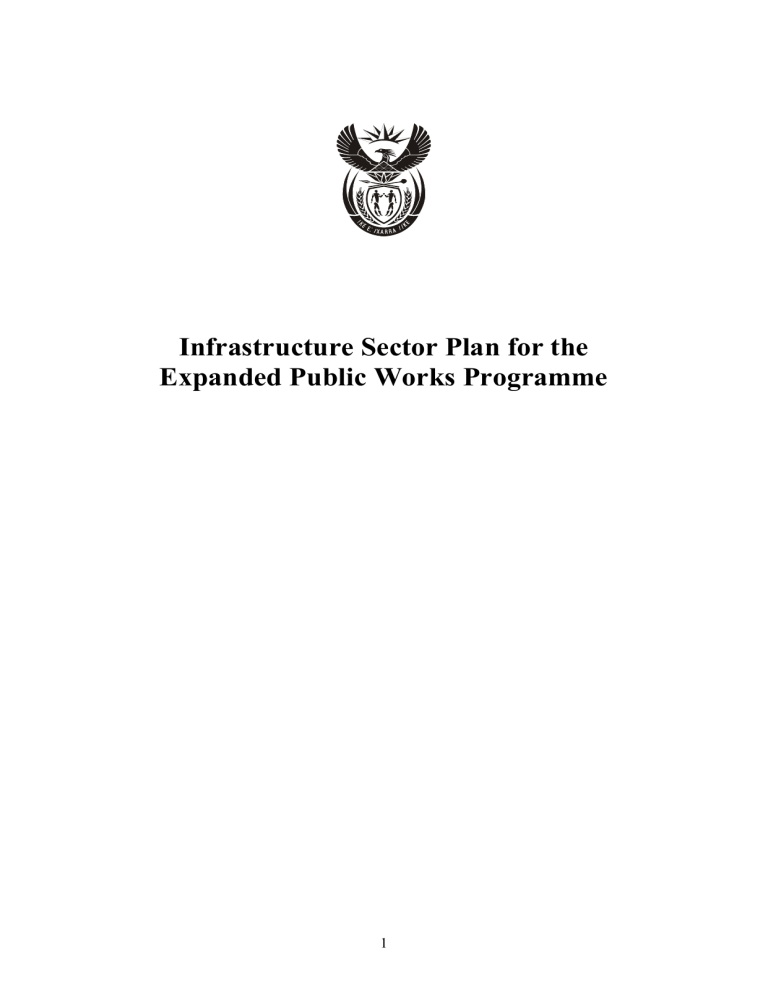
Infrastructure Sector Plan for the
Expanded Public Works Programme
1
1- Background
The Expanded Public Works Program aims to increase employment in the infrastructure sector by increasing the labour-intensity of government funded infrastructure programmes. The infrastructure sector has been identified as the largest employment generator in the EPWP with a target of at least 900000 work opportunities to be created over the first five years. The programme will focus on infrastructure amenable to the construction, rehabilitation and maintenance by Labour
Intensive methods provided by National Departments, Provinces and Municipalities.
The success of the programme will depend upon substantial training and capacity building within the sector. Interventions have been put in place as part of this sector plan to address training and capacity building needs.
2- Identification of focus areas within the infrastructure sector
The programme aims to achieve a large impact in a short time by focusing on construction, rehabilitation and maintenance activities which offer the best opportunity for use of labour. In particular, low-volume roads, trenching, stormwater and sidewalks have been identified as areas where construction, rehabilitation and maintenance using labour-intensive methods will increase steadily over time. The programme does not exclude other types of infrastructure and encourages all public bodies to expand the use of labour-intensive methods to other types of infrastructure.
These four focus areas will be targeted through attaching specific conditions to the
Provincial and Municipal Infrastructure Grants (PIG and MIG).
In addition to the infrastructure funded through the MIG and the PIG, additional areas of labour-intensive infrastructure provision and maintenance have been identified.
These areas include:
Labour intensive construction of civil works through the Department of
Housing (DOH)
Trenching in electrification projects through Eskom (DME)
Remaining CMIP projects earmarked for Labour Intensive Construction.
(DPLG)
2
Road Maintenance and higher volume roads (NDOT)
Building Maintenance (DPW)
3- Scope
The scope of the contribution of different Departments and State Owned Enterprises
(SOE’s) to the Expanded Public Works Programmes is as follows:
3.1 Provinces and Municipalities through the MIG and PIG
DPW has identified R15 billion of the Provincial and Municipal infrastructure grants for the next five years to be spent building infrastructure under the EPWP. Additional conditions will be attached to these conditional grants, making the use of the
“Guidelines for the implementation of Labour Intensive Projects under the Expanded
Public Works Programme (EPWP)” mandatory for provinces and municipalities to use when planning infrastructure projects funded through the PIG and MIG. These guidelines require the use of labour intensive methods for the construction of low volume roads, trenches, storm water drains and sidewalks.
The projected amount of infrastructure that provinces and municipalities will construct through projects meeting the requirements of the EPWP is 31000 km of pipelines, 1500 km of roads , 1500 km of storm water drains and 150 km of urban side walks over the next 5 years. A break down of the infrastructure to be constructed over the next 5 years is shown in Table 1 on the next page.
3
Table 1: Break down of Infrastructure to be constructed over the next 5 years
Targeted Categories of
Infrastructure
2004/5 2005/6 2006/7 2007/8 2008/9 Total
(Outputs-Kms)
Provincial Roads (Km)
(Regravelling, light seals)
4300 4800 5300 6000 6400 26800
1600 1900 2100 2300 2500 10400 Municipal Roads (Km)
(Regravelling, Light
Seals and Roads < 500 vpd) (Km)
Water Reticulation
(Pipelines) (Km)
4100 4800 5400 5800 6300 26400
Sanitation (Pipelines)
Storm water (Km)
Pavements (Km)
850
230
20
990
270
25
1000
300
30
1000
320
30
1100
350
35
5240
1470
150
The Guidelines prepared by DPW not only identify the types of projects to execute using labour, but also provide tender and design guidelines to assist provinces and municipalities in ensuring the proper labour intensive execution of these works. The guidelines also provide a very clear contractual framework for Provinces and
Municipalities, and ensure that clear contractual obligations exist for both consultants and contractors who are designing, supervising and executing these works. These guidelines will be distributed to all Provinces and Municipalities before 1 April 2004.
Expenditure on labour intensive infrastructure under the EPWP is scheduled to increase from R900 million in year one to R3,6 billion in year five. An estimated
750000 work opportunities and 250000 person-years of employment will be generated through the use of labour intensive methods for the construction of this infrastructure.
The break down of employment opportunities over the next five financial years through the Provincial and Municipal Infrastructure grants is as shown in Table 2 on the next page.
4
Table 2: Break down of Employment opportunities through the Provincial and
Municipal Infrastructure grants over the next 5 financial years.
Targeted Categories of
Infrastructure
Provincial Roads
(Regravelling, light seals)
Municipal Roads
(Regravelling, Light Seals and Roads < 500 vpd)
Water Reticulation
(Pipelines)
Sanitation (Pipelines)
Storm water
Pavements
Total
2004/5 2005/6
18400
10400
11400
2700
2100
100
61400
34700
37900
8900
7000
320
2006/7
73600
41600
45400
10700
8400
400
2007/8
73600
41600
45400
10700
8400
400
2008/9
73600
41600
45400
10700
8400
400
Total
300600
169900
196900
43700
34300
1620
45100 150220 180100 180100 180100 735620
3.2 Maintenance of Public Buildings
As part of the Expanded Public Works Programme, the Independent Development
Trust (IDT) has produced a business plan to act as the Programme Implementing
Agent for the National and Provincial Departments of Public Works in a programme of maintenance of public buildings aiming to create 34000 work opportunities per annum. The number of work opportunities is based on a budget of R 200 million, representing 20% of the total maintenance budget for National and Provincial Public
Works Departments.
4- Funding
The funding for the Expanded Public Works Programme will be through the alignment of existing funding as follows:
4.1 Provincial and Municipal Infrastructure Grants Funding
Approximately R15 billion of the MIG and PIG grants will be earmarked for EPWP over the first 5 years. Furthermore donor support was obtained for the development of NQF accredited courses for labour intensive construction. Projected infrastructure spending through the MIG and PIG on EPWP projects for the next five years will be as shown in Table 3 on the next page.
5
Table 3: Table showing Municipal and Provincial Infrastructure Grant spending
and jobs created for the first 5 years
Year
2004/5
MIG and PIG
EPWP spending
R 900 Million
Jobs created if cost of job creation
45,000
2005/6
2006/7
R 3 Billion
R 3,6 Billion
150,000
180,000
2007/8
2008/9
R 3,6 Billion
R3,6 Billion
4.2 Maintenance of Buildings
180,000
180,000
Projected spending is estimated at R200 million per annum according to the maintenance budgets of National and Provincial Departments (IDT Business plan,
2004).
4.3 Donor Funding
Some donor funded has been obtained and is being used to fund some aspects of the
Expanded Public Works Programme. Additional funding is also expected from the
Business Trust who have pledged to provide assistance.
5- Institutional Arrangements
5.1 Establishment of an infrastructure sector co-ordinating committee
An Infrastructure sector coordinating committee has been established. The Sector
Co-ordinating committee consists of:
Department of Public Works
Department of Transport
Department of Housing
Department of Provincial and Local Government
Department of Water Affairs and Forestry
Department of Public Enterprises
Department of Education
Eskom
IDT
6
5.2 Establishment of Provincial steering committees
Provinces have been requested to establish provincial steering committees to coordinate the EPWP programme provincially.
6 Support for Provinces and Municipalities
6.1 DPW Support Initiatives
The implementation process for the EPWP has been designed to minimise the burden placed on Provinces and Municipalities. The EPWP will place most of the burden on the private construction industry, namely the Consulting Engineering and
Contracting Industry, for implementation. Nonetheless, support for the provinces and municipalities will be required to ensure that they understand and execute their role in the programme. Support will be provided in the following ways:
DPW will develop and provide guidelines for the implementation of labour intensive projects by Provinces, Municipalities and Departments.
DPW will hold training sessions with the Project Management Units to be established by DPLG to enable these to be able to help manage EPWP projects at Municipal level.
DPW will provide training to Municipalities on the use of the Guidelines for implementation of projects under the EPWP.
6.2 DPLG support initiatives
The Department of Provincial and Local Government will establish Project
Management Units (PMU) to assist with the implementation of the MIG. DPW will engage closely with these PMU’s to ensure that they are able to support municipalities with projects that are part of the EPWP.
7
7- Training and Capacity Building
7.1 Training in Labour Intensive Construction
DPW has identified that the need for training in labour intensive construction exists at practically all levels and has therefore developed NQF accredited training at levels 2,
4, 5, 6 and 7. Consultants and Contractor staff working on these projects will be required to undergo relevant training courses. They will also have to fund these training costs themselves. Plans are underway to put in place bursaries for emerging
Consultants and Contractors.
DPW and CETA will develop capacity of training providers to provide training on the scale required by the EPWP. Together with the CETA fast track plans have been implemented and train the trainer courses have been held for level 4 and level 2.
Four additional train the trainer programmes have been scheduled to be provided before July 2004. At the levels 5 and 7 the required skills programmes are being finalised. Two training programmes at these levels have also been planned to be held before July 2004.
DPW and NDOT, together with Department of Science and Technology, the
Umsobumvu Youth Fund and LITE (Training NGO) are formulating a MOU that will lead to the establishment of a National Training College for Labour Intensive
Construction. DPW has agreed to make a building available to house this National
Training College and is currently looking for a suitable venue. The West Rand, East
Rand, Crown Mines and Northern Tshwane have all been identified as suitable areas.
The CETA learnerships for labour intensive contractors will also contribute significantly to building capacity for the execution of these types of work. 180
Learnership for contracts in the Infrastructure have been made available through
CETA and will be awarded in the first year of the Expanded Public Works
Programme.
7.2 Training of Workers and Exit Strategies
The nature of the labour intensive construction industry is such that projects, and therefore employment opportunities for labourers typically last only 4 to 6 months.
Based on the Code of Good practice for Special Works Programmes, this entitles labourers to only 8 to 12 days of paid training.
8
This is not sufficient to train unskilled labourers to become artisans. It has therefore been agreed with the DOL to create a generic 10 to 14 day training course that will consist of accredited unit standards on:
General Life skills,
Awareness of HIV and AIDS
Labour markets and the world of work.
During the course workers will also be provided with information about opportunities in learnerships and internships that are offered through various SETA’s and the private sector. In addition information about further education and training opportunities, especially for youth will be coordinated together with DOE. The
Umsobumvu Youth Fund will also assist with the identification and creation of exit strategies for youth.
8 Monitoring and Evaluation
Monitoring to be done through existing monitoring systems. The main monitoring systems that have been identified to be used are the MIG monitoring system to be developed by DPLG and the PIG monitoring system of National Treasury. The Key
Performance Indicators (KPIs) developed for the EPWP will be added to these monitoring systems so that they can be collected by DPW. In addition to these monitoring systems that will be used to collect the KPIs, other existing systems will be used to monitor and evaluate the EPWP. Some of these systems are:
DOL work seekers database
CIDB projects database
SETA databases of individuals who have completed accredited courses and unit standards.
The projects would be evaluated according to the following Key Performance
Indicators (KPI’s):
Work opportunities created
Person days of employment created
Number of training days provided
Spending on EPWP projects
Demographic characteristics of workers in the EPWP
9
Conclusion
More potential for creation of jobs exists in the Infrastructure sector, this sector plan gives highlights of the areas that have been identified and analysed so far, other potential areas to be included in later versions of the infrastructure sector plan.
10
